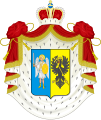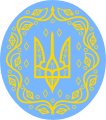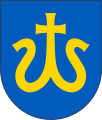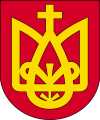Symbols of the Rurikids

Throughout the
Images of knyazes’ symbols

As a rule, on the coins of Kievan knyazes, one encounters figures resembling an inverted letter “П”, to which are added “offshoots” from below or in the middle, and likewise dots, crosses, etc. The same symbols could look different depending on the item on which they were depicted. Thus, the emblems of the knyazes on seals are depicted schematically, in a maximally simplified form, whilst on coins the same symbols have a large number of additional ornamental elements. The heraldic symbols of Rus’ knyazes are known to us not only in the form of depictions on coins and seals, but also on pendants, rings, weapons, etc. Based on these findings, it is possible not only to trace the evolution of the symbols of the knyazes of Kievan Rus’, but also to try to reconstruct their origins.
History
Origins
This section needs additional citations for verification. (May 2023) |
The use of depictions of the bident and trident makes the symbols of the Rurikids resemble the complex imperial coats of arms of the
Written sources
The first information on the emblems of Rus knyazes comes from the middle of the 10th century.
Decline of the personal symbols of the knyazes
The knyazes’ personal symbols proliferated widely over the territory of the Kievan Rus’. Seals with their images notarized state documents,[7] coins were minted with the symbol of the knyaz, and artisans branded their products with the knyaz's coat of arms. The “coat of arms” of the knyaz was borne by the tivuns and the druzhina. In this form the symbols of the Rurikids survived to the middle of the 12th century. In the 13th century the coats of arms of the knyazes practically wholly fell into disuse, which is often associated with their evolution. According to many scientists, the schemes of the arms simplified so much that they lost the ability to create variants marking individual ownership.[8] Consequently, the knyaz's “coat of arms” lost its personal character and acquired the character of the emblem of a place or the coat of arms of a family.
-
Coat of arms of the princes of the Czetwertyński family.
-
Coat of arms of the princes of the Druccy family.
-
Coat of arms of the princes of the Ogiński family.
-
Coat of arms of the princes of the Volkonsky house.
-
Coat of arms of the princes of theDolgorukovfamily.
Modern usage
Despite the fact that the heraldic symbols of the knyaz of Kievan Rus’ ceased to be used in the 13th century, in the 20th century some of them began to be used in the role of coats of arms and emblems.
Coat of arms of Ukraine
-
Coat of arms of Ukraine.
In 1917 after the
-
Small coat of arms of the Ukrainian People's Republic.
-
Large coat of arms of the Ukrainian People's Republic.
-
Coat of arms of the Ukrainian State.
-
Coat of arms of Carpatho-Ukraine.
-
State seal of theUkrainian National Government (1941).
After the collapse of the
Coats of arms of administrative divisions of Ukraine
In the coats of arms of the cities,
-
Coat of arms of Chernihiv Oblast.
-
Coat of arms of Halych.
-
Flag of Halych.
-
Banner ofShatsk, Ukraine.
-
Coat of arms of Vinnytsia
Symbolism of Ukrainian institutions and organizations
The trident of Vladimir is used in the symbolism of the state institutions of Ukraine, and its stylizations still continue to be used in many Ukrainian organizations throughout the world.
-
The emblem of the Ukrainian Ministry of Defence.
-
Emblem of theFootball Federation of Ukraineuntil 2016.
-
Current emblem of the Ukrainian Association of Football.
-
Coat of arms of theOrganization of Ukrainian Nationalists(1929—1940, Melnyk faction after 1940).
-
Emblem of the scouting organization Plast.
-
Emblem of the People's Movement of Ukraine.
-
Flag of the right-wing paramilitary and political party Right Sector.
Religious symbolism


A modified trident of Saint Vladimir was found as a basic element of the coat of arms of the Ukrainian Autocephalous Orthodox Church (UAPC) before it merged to form the Orthodox Church of Ukraine.
The trident of Volodymyr is also used by followers of the Native Ukrainian National Faith, a branch of the Slavic Native Faith, as part of the basic symbol of their religion — the trident umbegone by sunbeams.
Coats of arms of administrative divisions of Belarus
In
Coats of arms of administrative divisions of Russia
In Russia the falcon of Rurik is used as a component of the coats of arms of several settlements and raions. The fast bird image is perceived as Rurik's family totem.[11][12] The image of the falcon, symbolizing the heroic warrior, knyaz leading his military squad, is repeatedly mentioned in the cornerstone of ancient literature of Kievan Rus The Tale of Igor's Campaign.[13] As a patrimonial symbol of knyazes, the image of falcon has been present on the flags and emblems of several Russian cities, such as Suzdal, Sokol, Kumertau, and others.
-
Coat of arms of Staraya Ladoga
Coats of arms of armed forces of Italy

The trident of Vladimir is present on the coats of arms of all the
Emblem of the NTS
The trident of Vladimir is also used by the
References
- ^ Яценко С. А. Знаки-тамги ираноязычных народов древности и раннего средневековья. М. 2001.
- ^ Плетнева С. А. От кочевий к городам. Салтово-маяцкая культура. М. 1967. С. 128.
- ^ Флерова В. Е. Образы и сюжеты мифологии Хазарии. М. 2001. С. 53 — 54.
- ^ Шахматов А. А. Повесть временных лет, т. I, Petrograd, 1916, с. 69.
- ^ Русская Правда по спискам Академическому, Карамзинскому и Троицкому. Edited by Professor Б. Д. Грекова. Moscow — Leningrad, 1934, с. 6.
- ^ Рыбаков Б. А. Знаки собственности в княжеском хозяйстве Киевской Руси X—XII вв., с. 230.
- ^ Янин В. Л. Актовые печати Древней Руси X—XV вв., т. 1-2. Москва, 1970.
- ^ Янин В. Л. Княжеские знаки суздальских Рюриковичей. — КСИИМК, 1956, вып. 62, с. 16.
- ^ Постановление Верховного Совета Украины от 19 февраля 1992 года № 2131-XII.
- ^ Закон «Конституция Украины» от 28 июня 1996 года № 254к/96-ВР.
- ^ "Герб Старой Ладоги" [Coat of arms of Staraya Ladoga]. heraldicum.ru (in Russian). Retrieved 24 May 2020.
The connection of the Rurik symbols with the world of birds is supported by a large group of scholars
- ^ Voitovich, Leonid. "Рюрик и происхождение династии Рюриковичей: новые дополнения к старым спорам" [Rurik and the origin of the Rurik dynasty: new additions to old dispute]. cyberleninka.ru (in Russian). Retrieved 24 May 2020.
O. Rapov, who saw the trident as a falcon flying down, suggested the bird could be Rurik's family totem, while indicating that it was not generally worshiped among the Slavs or the Scandinavians
- ISBN 5-86007-009-8
- ^ Charter of the National Alliance of Russian Solidarists
Bibliography
- Болсуновскій К. В. Родовой знакъ Рюриковичей, великихъ князей кіевскихъ. Геральдическое изслѣдованіе, предназначенное къ чтенію на XIV Археологическомъ Съѣздѣ в г. Черниговѣ. Kiev, Typo-lithography by С. В. Кульженко, 1908; 8 с.: ил.
- Русская Правда по спискам Академическому, Карамзинскому и Троицкому. Edited by Professor Б. Д. Грекова. Moscow — Leningrad, 1934.
- Рыбаков Б. А. Знаки собственности в княжеском хозяйстве Киевской Руси X—XII вв.
- Шахматов А. А. Повесть временных лет, т. I, Petrograd, 1916.
- Якубовский А. Ю. Ибн-Мискавейх о походе русов в Бердаа в 943—944 гг. in “Византийский временник”. Leningrad, 1926, т. XXIV.
- Янин В. Л. Актовые печати Древней Руси X—XV вв., т. 1-2. Moscow, 1970.
- Янин В. Л. Княжеские знаки суздальских Рюриковичей. — КСИИМК, 1956, вып. 62.
- Молчанов А. А. Знаки Рюриковичей: итоги и проблемы изучения // Древнейшие государства Восточной Европы. 2005. Рюриковичи и Российская государственность. — М., 2008. — С. 250—270.



























